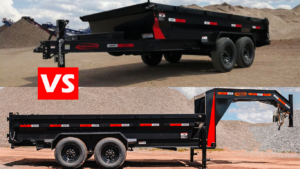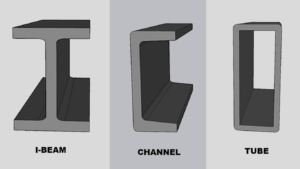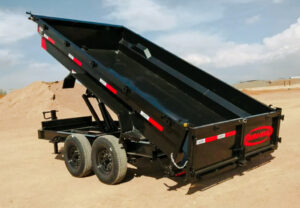How To Choose The Right Dump Trailer
How To Choose The Right Dump Trailer
Posted on January 25, 2023

So what needs to be considered when we are choosing our dump trailer? There are many factors. Below, we will go over the main ones including: bumper pull vs gooseneck, size, weight, durability, and features for various types of jobs.
1. Dump Trailer Size
To determine the size required, we first need to consider what we need the trailer to accomplish. If we are using it to haul machinery, obviously, we need to make sure that the machinery will fit in the trailer. For example, if we need to haul a John Deer 26G excavator we look at the transport length and track width (which are 13 ft 9 in and 4 ft 11 in), we know that the Dura-Haul 7×14 dump trailer can handle this no problem with the interior being 14ft by 7ft.
If we are looking at hauling materials (gravel, dirt, garbage, construction waste), we are probably thinking about trailer size a little differently. In this case we are thinking more in terms of volume rather than length and width. For example, if we need to move up to 15.5 cubic yards of gravel, the Dura-haul 14ft dump gooseneck high-side would be a great fit. However, if we only need a capacity of 7.71 cubic yards, we can downsize to the Dura-Haul 14ft Bumper Pull or the Dura Haul 14ft Gooseneck with low sides.
2. Weight
When choosing the right trailer for the job, we need to think about how much weight we need to move, what our truck can handle and what our trailer can handle. GVWR stands for Gross Vehicle Weight Rating which is the maximum amount of weight your trailer can be when fully loaded. So GVWR – trailer weight = maximum payload (assuming your truck can handle at least as much as the trailer).
When hauling heavier loads, it is important to make sure your whole trailer can handle it. Often times, the listed GVWR is mostly based on what the axles and tires can handle. So it is possible you could end up with a trailer with two 7,000lbs axles but a weak channel or tube frame and insufficient bracing under the bed. This will be a problem down the road if you are consistently hauling 10,000lbs loads.
3. Bumper Pull or Gooseneck?
Both options have their advantages and disadvantages. We will not go too deep into that here as we already have an entire article on the topic which can be found by clicking below. Examples of considerations discussed in this article are: turning radius, weight distribution and truck compatibility.

4. Build Quality
This is one of the most important considerations. We need to make sure that our trailer can handle what we are throwing at it and be reliable. Buying a cheaper trailer may save you some money upfront, but if you are constantly dealing with repairs and downtime, those savings will disappear very quickly.
Materials and design play a big role here. One thing we want to look at is the gauge of steel used. For the floor of the trailer, common gauges used are 7 gauge (3/16 inch) and 10 gauge (9/64 inch). 7 gauge is used for heavy duty trailers whereas 10 or 11 gauge may be used for lighter duty smaller trailers that don’t take as much abuse. Some manufacturers will use 12 or 14 gauge for the flooring – this tends to be a red flag. The advantages of a lighter gauge are cost savings and reducing the overall weight of the trailer, but this comes at the cost of durability.
The frame is very important when determining whether or not you have a strong trailer. Many trailers are built with tube or channel frames, which offer little structural integrity compared to I-beam. I-beam is a vertical piece of steel welded to two horizontal flanges. This allows optimal handling of vertical and horizontal stress.

Another major factor when considering the durability of our trailer is the finish. The common options are paint and powder coating. Paint is cheaper, but powder coating is far superior as it is highly resistant to chipping, scratching and wear. This will mean that, not only will your trailer look better, but more importantly, it will be much more resistant to rust, therefore will last longer.
There are many other factors when considering the build quality of a trailer including bracing/cross-members, quality of components (like the lifting mechanism, and battery), suspension and more. However, this should give you a good idea of where to start looking.
5. Functionality
Size, capacity and quality are fairly obvious considerations when choosing a dump trailer, however, we also need to think about whether or not we have all of the right features we need to get the job done. Here are a few examples:
Spreader gate – if we are using the trailer to spread gravel or other materials, we need to make sure that it has a spreader gate. This is where the back of the trailer opens at the bottom only to control the amount of material coming out.

AC Charger – If we cannot always rely on having a truck nearby to charge the battery, we probably want to be sure that we have an AC/DC converter built in so that we can charge off an outlet.
Heavy Duty Fenders – If your job requires you to climb onto the sides of the trailer regularly, you want to make sure that you have steps and/or fenders that can support your weight. Many trailers are built with very cheap flimsy metal fenders so this is something to watch out for. (many dump trailers do not have this, all Durahauls do).
Dual Acting Hydraulic Unit – If speed and time efficiency are important to you, a dual acting hydraulic unit is probably something that you want. What some people may not know if that many hydraulic trailers are not equipped with a hydraulic up and hydraulic down. With a single acting hydraulic unit, the pump is used to move the trailer up but to move the trailer down, it relies on gravity alone. This means longer weight times when lowering your trailer.
Ramps – If you are buying a dump trailer, chances are, you need ramps. You may not be regularly loading an excavator or ATV, but even if it is not part of your regular work day, ramps will be something worth having at some point.

Connection Points – This is something that can be overlooked when choosing a dump trailer. If you are loading any kind of equipment into your dump trailer, you need to have something you can attach straps or chains to like D-rings. If you are stuck without these, you may find yourself in a situation where you cannot properly secure your load which will create issues with safety.
Final Thoughts
There is a lot of information here, all of it relevant when choosing a dump trailer. It is important to know that not all dump trailers are alike, every make has their differences. The best first step you can make when choosing the right trailer is choosing The Dura-Haul Difference, an uncompromised commitment to quality. Call us today so we can help you find the trailer that is right for you.
